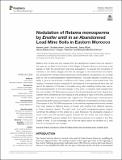Por favor, use este identificador para citar o enlazar a este item:
http://hdl.handle.net/10261/193111COMPARTIR / EXPORTAR:
 SHARE SHARE
 CORE
BASE CORE
BASE
|
|
| Visualizar otros formatos: MARC | Dublin Core | RDF | ORE | MODS | METS | DIDL | DATACITE | |

| Título: | Nodulation of Retama monosperma by Ensifer aridi in an Abandonned Lead Mine Soils in Eastern Morocco |
Autor: | Lamin, H.; Alami, S.; Bouhnik, O.; ElFaik, S.; Abdelmoumen, H.; Bedmar, Eulogio J. CSIC ORCID; Missbah El Idrissi, M. | Palabras clave: | Retama monosperma, Mining site tailings, Ensifer aridi, Housekeeping genes, Symbiotic genes | Fecha de publicación: | 2019 | Editor: | Frontiers Media | Citación: | Frontiers in Microbiology 10 (2019) | Resumen: | Millions tons of lead and zinc wastes from the abandoned Touissit mine are stored in the open air as dikes in the vicinity of the villages in Eastern Morocco and pose a real danger to both the environment and local populations. To prevent the movement of minerals to the nearby villages and limit the damages to the environment and health, we proposed the nitrogen-fixing leguminous shrub Retama monosperma, as a model plant to use for phytostabilization experimentations. This plant species is known by its ability to grow in hard climatic conditions and in heavy metals contaminated soils. The isolation of bacterial strains nodulating R. monosperma in the abandoned mine soils will permit the selection of rhizobia to inoculate young plant seedlings before their use for the phytostabilization of the mine tailings. In this work, 44 bacteria were isolated from the root nodules of R. Monosperma grown in the Touissit abandoned mine. Twenty-four isolates were considered as true rhizobia as they possess a copy of the nodC symbiotic gene and were able to renodulate their original host. The phenotypic characterization showed that all the strains are tolerant in vitro to different concentrations of heavy metals. The analysis of the 16S rRNA sequences of two selected representative strains showed they were related to different strains of Ensifer aridi isolated from different legumes in three continents deserts. The glnII, recA, and gyrB housekeeping genes analysis confirmed the affiliation of the strains to E. aridi. Moreover, the phylogenic analysis of nodA, nodC, and nifH symbiotic genes showed that the strains are more related to E. aridi JNVUTP6 species isolated from Tephrosia purpurea root nodules in the Thar Desert in India. To our knowledge, this is the first report about the isolation of E. aridi from R. monosperma root nodules. | Versión del editor: | https://www.frontiersin.org/articles/10.3389/fmicb.2019.01456/full | URI: | http://hdl.handle.net/10261/193111 | DOI: | 10.3389/fmicb.2019.01456 | Identificadores: | doi: 10.3389/fmicb.2019.01456 issn: 1664-302X |
| Aparece en las colecciones: | (EEZ) Artículos |
Ficheros en este ítem:
| Fichero | Descripción | Tamaño | Formato | |
|---|---|---|---|---|
| 2019_Lamin_FM_OA.pdf | 2,76 MB | Adobe PDF |  Visualizar/Abrir |
CORE Recommender
PubMed Central
Citations
5
checked on 15-abr-2024
SCOPUSTM
Citations
17
checked on 12-abr-2024
WEB OF SCIENCETM
Citations
16
checked on 26-feb-2024
Page view(s)
218
checked on 19-abr-2024
Download(s)
252
checked on 19-abr-2024

